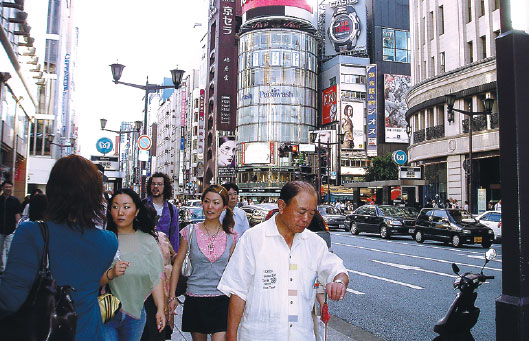Cool currency
Japan becomes a top destination for Chinese tourists as the yen depreciates against the yuan, Yang Feiyue reports.
Zhang Shiyi spent more than 20,000 yuan ($3,200) on health aids on her recent trip to Japan.
She believes her mother's health has since improved. "The yen's depreciation against the yuan gave me incentives and made me splurge a little," says Zhang, who works in Beijing.
Chinese tourists are heading to Japan as its currency depreciates. More than 2.5 million Chinese traveled to Japan from January to November in 2014, up 51 percent as compared with the same period in the previous year, the China National Tourism Administration says.
Japan was China's third-biggest outbound tourist destination last year, after South Korea and Thailand, says Dai Yu, marketing director at online travel giant Ctrip's tourism department. The company arranged Japan trips for hundreds of thousands Chinese last year, she adds.
The destination offers seasonal sceneries, culture, security and celebrated cuisine, Dai says.
Zhang was most impressed by Japanese society's eye for detail. "It was clean and comfortable, especially the streets and washrooms," she says.
A major attraction is Sensoji - aka Asakusa Kannon Temple - where visitors pray for blessings, buy knickknacks and savor local fare, Dai says. Shinsaibashi Plaza at the heart of Osaka is any foodie and shopper's paradise, she adds.
China's proximity to the island nation has become more critical since the yen's depreciation, and relaxed visa and tax policies, according to Beijing-based China Tourism Academy's International Tourism Development Institute director Jiang Yiyi.
Japan's currency dropped 20 percent against the yuan in 2013, and fell between 10 and 12 percent last year, she explains. So traveling to Japan is about 20 to 30 percent cheaper now. The difference makes visits to Japan even more economical than some domestic destinations, National Public Opinion Poll chief analyst Liu Zhiming says.
Shopping has long remained a draw for Chinese. "They not only buy household appliances but also health aids and cosmetics," he says. Chinese travel to Japan has evolved beyond just sightseeing to include a whole host of leisurely activities.
There are many family-friendly sites, such as Osaka's Universal Studios, ski slopes and the cherry blossoms, Liu says. Japan also recently built large-scale shopping outlets that lure Chinese customers.
Last year, the country extended the classification of duty-free products from durable consumer goods such as electric appliances to ordinary items such as food and cosmetics.
Visitors are exempted from the 8 percent consumption tax at purchase sites, Jiang says. In addition, multiple-entry visas' validity was extended from three to five years on Jan 19.
"Japan has continued to lower the threshold for Chinese tourists over the years," Jiang says.
Chinese previously needed to earn 250,000 yuan annually to apply for visas. But now credit card holders can qualify. The relaxed rules will pave the way for more favorable future policies, says Hideki Ijichi, director of the Japan National Tourism Organization's Beijing office.
Chinese-language services are available once tourists get off the plane and go through customs. And Chinese-language tours are also increasingly available at scenic spots and hotels, Jiang adds.
Even Japanese-appliance store LAOX offers Chinese services. Liu believes the volume of Chinese tourists to Japan will maintain a 30-percent growth this year..
As unexpectedly as the yen's fall led to a surge in Chinese tourism, the economic winds could rush in a very different direction in 2015.
Only time will tell.
Contact the writer at yangfeiyue@chinadaily.com.cn
|
Top: Kinkakuji , or Golden Pavilion, in Kyoto is among Japan's popular tourist attractions. Above: Chinese tourists like buying household appliances, health aids and cosmetics in that country. Photos By Xiao Yang / For China Daily |



















